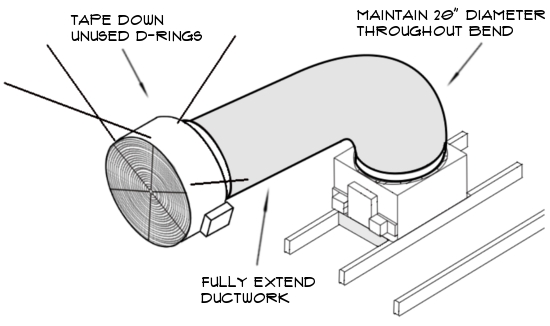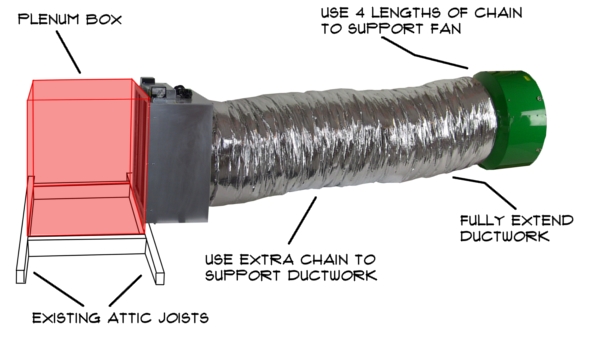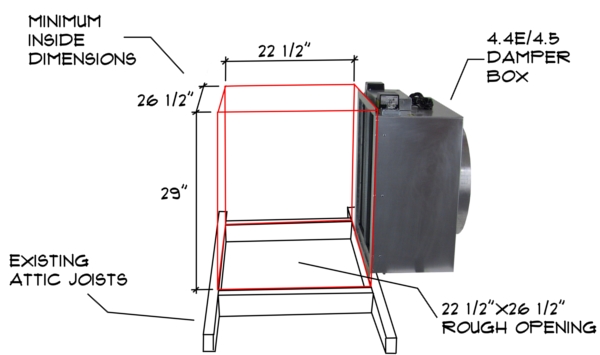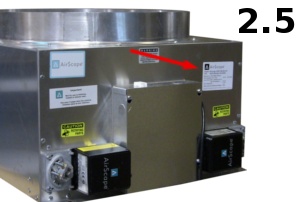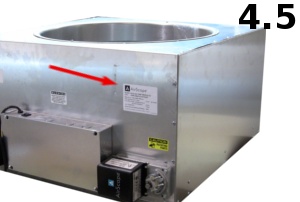Over the years ve’ve also fielded a lot of questions from customers wanting to know if our fans’ dampers can be installed vertically (i.e. in a wall rather than over a ceiling) or at an angle on top of a vaulted ceiling. The short answer to both questions is “yes”, but there are some important limits that need to be considered, which we’d like to go over. Please note: this blog post is limited to our line of AirScape fans—Kohilo models will be covered in a future post.
4.4e WHF
Sound Reduction part 4 – Ducted Models
The final step on our journey of sound reduction brings us to ducted AirScape models. As you already know the ducted design of the 2.5 WHF, 2.5e WHF, 4.4e WHF, 4.5 WHF, and the Kohilo 2.8 allow for maximum airflow with a minimum of noise. Improper installation of these models can increase their sound levels. We touched on this subject earlier in the blog “4.5 Installation – Maximize Airflow, Minimize Noise.” There are a few things you need to consider when installing a ducted model.
90 DEGREE BEND – The 90 degree bend should be as smooth as possible to maintain the 20″ diameter of the ductwork. Kinking the ductwork will increase the sound level and reduce airflow because the air does not have a smooth path to the fan.
EXTENSION – It is important to extend the ductwork as far as possible away from the damper box. This needs to be done without distorting the 90 degree bend in the ductwork. Extending the ductwork fully moves the sound source (the fan) to the farthest point from the living space.
D-RINGS – The 2.5, 2.5e, and 4.4e fans have D-rings which are used to hang the fan from the attic rafters. Only 4 of the 8 D-rings are used in the installation. The unused D-rings should be taped down to avoid excess rattling.
PART 1 / PART 2 / PART 3 / PART 4
4.4e/4.5 Install: Low Attic Clearance
Often a WHF will not easily install in the traditional horizontal position. In some instances trusses or other obstructions will interfere with a normal installation. More often there is not enough clearance between the attic floor and the roof. One solution is to create a plenum box which the WHF will attach to. The plenum box can easily be constructed out of plywood and 2×4’s. The red line in the photos represents the plenum box constructed for an AirScape 4.4e installation. The flexible ductwork and fan can then be mounted straight off of the damper box (the ductwork may have to angle slightly upward so that the fan does not touch the attic floor). A 90 degree bend in the ductwork is not necessary for sound attenuation in this application.
Installation Notes:
– Line the inside of the box with a layer of sheetrock to maintain any required fire ratings
– Use a sound attenuating duct liner for maximum sound reduction
– Seal all framing joints with latex caulk to make the box air tight
– Insulate the outside of the box to minimize heat loss
– Support any sags in the ductwork with additional chain
Where to find your AirScape model, version, and serial number
If you decide to add a remote kit after your initial purchase, the AirScape model, version, and serial number will be required in order to give you the correct remote for your unit. This information is also needed by our technical support staff to diagnose or troubleshoot an issue with your WHF.

